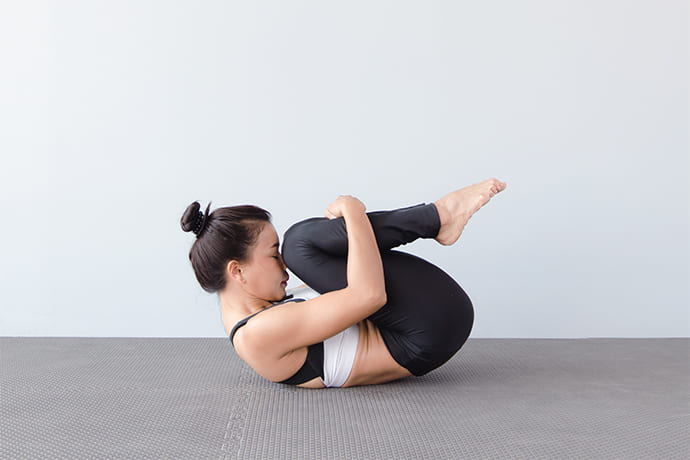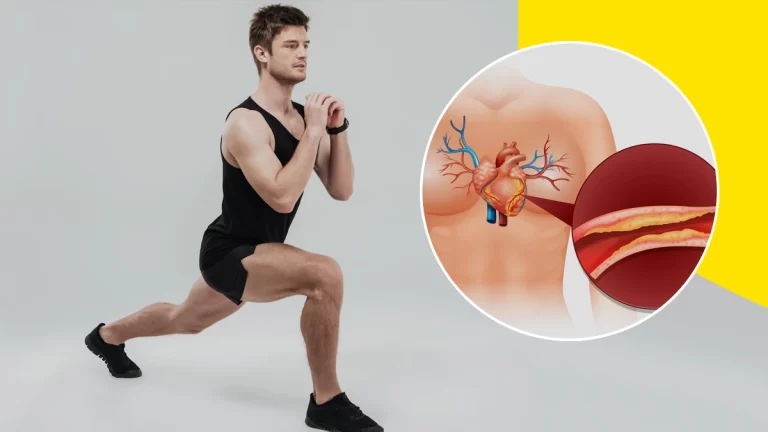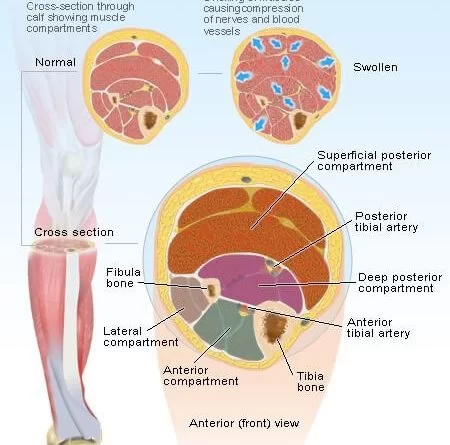15 Best Exercises For Middle Back Pain
It is commonly acknowledged that exercise is essential to the treatment and management of middle back pain. But not all exercises are made equal, and picking the right ones can have a significant impact on both long-term back health and pain alleviation.
Table of Contents
Introduction:
A complex structure composed of bones, muscles, nerves, and ligaments, the middle back is also referred to as the thoracic spine. It facilitates movement, protects important organs, and supports the upper body.
A common problem that many people deal with regularly is middle back pain. Regular exercise relieves pain in the back and keeps it from getting worse. The central region of the back can be strengthened and developed with the help of exercises for middle back pain. This has an impact on spinal health, functional fitness, and overall posture.
The mid-back supports the spine, facilitates mobility, and helps maintain proper posture. Incorporating a productive workout into your daily routine can help tone this area. It can also help strengthen and improve the health of the spine.
Your middle back can properly support your spine if you incorporate these workouts into your everyday regimen. Muscle imbalances are alleviated and mobility is enhanced with these easy yet effective exercises for middle back pain. As a result, everyday activities may have a stronger basis.
Remember that consistency is essential. For long-lasting results, make these stretches and exercises for middle back pain a regular part of your regimen.
Causes:
Herniated discs
- Herniated discs in the thoracic spine can provide intense, localised pain, although they are more prevalent in the lower back.
Spinal Stenosis
- The spinal cord and nerves may be compressed as a result of this spinal canal constriction.
Osteoarthritis
- Stiffness and pain may result from spinal joint wear and strain.
Scoliosis
- Pain might result from muscular imbalances and strains caused by an irregular sideways curvature of the spine.
Underlying Conditions
- Middle back pain can be caused by kyphosis, scoliosis, or even illnesses like kidney infections.
Muscular Problems and Damage
- This is among the most frequent reasons. It may be caused by repetitive actions, a forceful, awkward movement, or a muscle strain or sprain from incorrect lifting.
- Chronic pain can result from poor posture, which can be caused by slouching or a sedentary lifestyle.
- It can also cause muscle fatigue and tension in the spine.
Signs and symptoms:
There are many different ways that middle back pain can appear, and the particular symptoms can frequently give indications about the underlying cause.
The following are typical indications of middle back pain:
Restricted Mobility and Stiffness
- The spine’s flexibility has decreased.
- Difficulties bending, twisting, or reaching overhead.
- Sensation of tense muscles in the middle of the back.
Symptoms associated with muscles
- Spine-related muscle knots or spasms.
- Sensitivity when applying pressure to the spine or muscles.
- Fatigue or weakness in the back muscles following an activity.
Posture-related Indications
- Prolonged standing, sitting, or bad posture worsens the pain.
- Relief when shifting positions or resting.
Pain
- Middle back pain that might be dull, painful, or acute.
- Pain that could be tight, searing, or stabbing.
- Pain that may radiate (spread) over the chest, abdomen, or ribs.
Exercise’s advantages:
Stretches and middle back workouts have numerous advantages. Take it slow and pay attention to your body.
The primary benefits consist of:
Increases Mobility and Flexibility
- The spine and the surrounding muscles’ range of motion is increased by mild stretching and mobility exercises.
- This facilitates daily motions and lessens stiffness.
Lessens Tense and Stiff Muscles
- Tight muscles receive more blood flow when you exercise.
- This relieves stiffness and knots in the muscles, particularly those caused by prolonged sitting or bad posture.
Reduces Tension and Encourages Calm
- Exercise causes the release of endorphins, which lessens the sense of pain.
- Pain in the back is frequently made worse by stress, and exercise promotes mental and physical relaxation.
Increases Healing and Circulation
- By increasing circulation, exercise helps the spinal tissues receive oxygen and nutrients.
- This promotes the recovery of small wounds, Inflammation, or middle back muscular strains.
Enhances Core Stability
- By stabilising the trunk, core-strengthening activities lessen the strain on the thoracic spine.
- When moving, the stable core helps in the even distribution of forces.
Better health of the spine
- The general health of your spine can be enhanced by stretching and exercising your mid-back.
- The spine’s natural curve is supported by a strong and flexible centre back.
Improves Posture
- Posture is improved with specific workouts for the shoulders, core, and upper back.
- Proper posture reduces thoracic spine tension and stops additional pain.
Enhances Back Muscle Strength
- Strengthening the spinal muscles through exercise enhances their capacity to support the middle back, or thoracic spine.
- Muscle strength lessens the strain on discs, ligaments, and spinal joints.
Improved breathing techniques
- A strong, flexible middle backside facilitates healthy breathing habits.
It is important to consider the following safety precautions before starting an exercise program:
Before starting any fitness program, it’s essential to think about a few safety precautions and maximise the advantages. Consult your physician or physiotherapist to determine which exercises are most appropriate for your specific issue.
You should pay attention to your body’s needs and avoid pushing yourself when it seems uncomfortable. While some soreness is a normal side effect of exercise, chronic or severe pain may be a sign of overwork. Work your way up to more difficult workouts by beginning with low-impact ones until you can handle more pain.
It is possible to avoid repetitive injuries by keeping proper form and posture. If you are unclear about how to start exercising properly, you should speak with a doctor. Warm up your joints and muscles before starting any exercise to get them ready for the task.
Exercises For Middle Back Pain:
You can reduce pain and improve the muscles surrounding your thoracic spine by including regular exercises in your routine.
The best exercises for middle back pain are as follows:
Bird dog exercise
Bird dog exercise steps:
- Start by calming down on all fours while seated on a tabletop.
- Now place your knees beneath your hips and your hands beneath your shoulders.
- Keep your spine in a neutral position.
- Between your shoulder blades, squeeze.
- Next, lift your left leg and right arm to the ceiling.
- Your hips and shoulders should remain parallel.
- Hold this position for a few seconds.
- Then return to your neutral position.
- Then relax.
- Repeat these exercises 5 to 10 times.
- On the other side of your body, repeat the exercise.
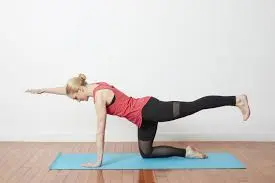
Thread the needle
- Get into a tabletop or quadrupod position.
- Maintain a flat back and tuck your chin in.
- Be sure to strengthen your core.
- With your left arm, extend upward and then guide it beneath your immovable right arm as if the moving arm were a thread through a needle while you maintain your weight on your right hand.
- Reach your left arm farther into the stretch and twist your spine while maintaining a straight lower back and hips.
- Drop your head and shoulders until your left ear and shoulder are resting on the floor.
- As you reach your left arm further into the position, you will notice the twist in your thoracic spine. Keep in mind that your lower back and hips should remain stable.
- This maintains your lower back muscles while applying pressure to the twist in your spine.
- Hold the stance for a second once you feel the stretch.
- Then return to your neutral position.
- Then relax.
- Repeat these exercises 5 to 10 times.
- Use the other arm to perform the stretch again.
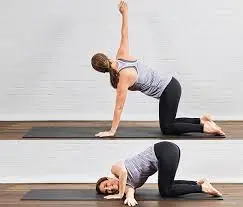
Seated row
- Take a seat on the floor to begin.
- Extend your legs.
- Wrap the resistance band around both of your feet now.
- With your palms facing in, take a neutral grip on the bar.
- Maintaining a straight back and slightly bent legs.
- Your shoulders should be back, and you should be sitting up straight.
- This is where you start.
- Hold the handle in your stomach while keeping your body in the same position.
- Squeeze and pull your shoulder blades back.
- Hold this position for a few seconds.
- Then return to your neutral position.
- Then relax.
- Repeat these exercises 5 to 10 times.
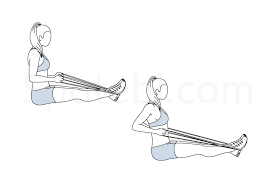
Cat-cow
- Begin by assuming the tabletop position with your hands and knees on the floor.
- Be sure you have a straight back.
- Keep both hands and feet grounded.
- Inhale, raise your head, and let the air fill your abdomen.
- Hold this position for a few moments.
- Then exhale, draw your chin into your chest, and bend your back towards the ceiling.
- It gently stretches your lower back.
- Hold this position for a few seconds.
- Then return to your neutral position.
- Then relax.
- Repeat these exercises 5 to 10 times.
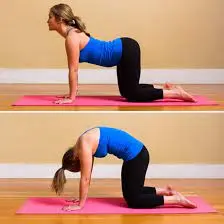
Bridge Pose
Bridge Pose steps:
- Lie flat on your back with your feet flat on the floor and your knees bent.
- Your heels should be within reach of your fingertips.
- To make your chest extend slightly forward, firmly press your shoulders into the floor and then softly tuck them deeper into your back.
- Put pressure on your feet and raise your hips.
- Hold your hands beneath you and slowly raise your hips towards the ceiling by pressing them into your arms and feet.
- Focus on the place behind your heart in your upper back, then carefully push your chest against the wall behind you.
- As a result, the backbend moves further towards the middle and upper back and away from the lower back.
- Hold this position for a few seconds.
- Then slowly lower yourself, release your grip, and put your hands to rest at your side.
- Then return to your neutral position.
- Then relax.
- Repeat these exercises 5 to 10 times.
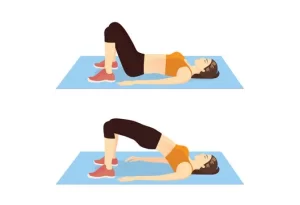
Child pose
- Get down on your knees.
- Sit on your heels, touch your big toes together, and then spread your knees apart by almost the same width as your hips.
- After exhaling, fold forward and place your body between your thighs.
- Your hip points should be lowered towards your abdomen so that they rest on the inner thighs.
- Lengthen your tailbone away from the back of your pelvis and widen across the sacrum.
- For the Extended Child’s pose, walk your hands out towards the front of your mat.
- Let the shoulder blades spread widely across your back due to the weight of your shoulders.
- Then return to your neutral position.
- Then relax.
- Repeat these exercises 5 to 10 times.
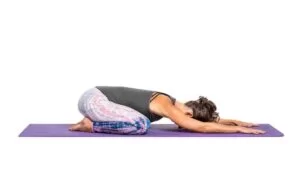
Cobra pose
- Start in a prone position on the floor.
- Place your palms flat on the floor near your shoulders.
- As you grip your sides, your elbows should be straight back.
- Take a moment to stand back and maintain a neutral neck position while looking directly down at your mat.
- Put your pubic bone down on the floor.
- Inhale to lift your chest off the floor.
- Roll your shoulders back while keeping your lower ribs on the floor.
- Don’t forget to keep your elbows at your sides.
- Stop them from moving in different ways.
- Keep your neck in a neutral position.
- Don’t take your eyes off the ground.
- Hold this position for a few seconds.
- Exhale to get back on the ground.
- Then return to your neutral position.
- Then relax.
- Repeat these exercises 5 to 10 times.

Doorway stretch
- To begin, stand in a split stance with both elbows and forearms resting on a doorframe.
- Raise your elbows until they are around shoulder height.
- To feel a stretch at the front of your shoulders and chest, slowly bend forward.
- For a few seconds, hold this stretch.
- Lean back and slowly release the stretch.
- Then return to your neutral position.
- Then relax.
- Repeat these exercises 5 to 10 times.
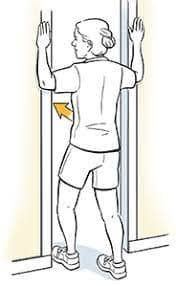
Superman
Superman steps:
- Start by relaxing while lying on your stomach.
- Raise your arms in front of you while maintaining a straight leg position.
- Maintaining a neutral head position.
- Now carefully lift your arms and legs to a comfortable height off the floor.
- To strengthen your core muscles, lift your stomach slightly off the floor.
- The muscles in your lower back are contracting.
- Hold this position for a few seconds.
- Then return to your neutral position.
- Then relax.
- Repeat these exercises 5 to 10 times.

Seated Spinal Twist
- Sit comfortably on the floor and extend both legs in front of you.
- After that, bend your left knee and lay it flat on the outside of your right thigh.
- Place your right arm outside of your left leg at this moment.
- Keep your hand behind you.
- Gently turn your body to the left.
- Hold this position for a few seconds.
- Then return to your neutral position.
- Then relax.
- Repeat these exercises 5 to 10 times.
- Proceed to the other side.
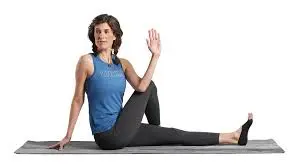
Wall angels
- Place your knees slightly bent, feet a few inches apart, and your back against a wall.
- Apply pressure on the wall with your head, upper back, and lower back.
- To keep this contact, contract your core.
- Make a “W” formation with your arms against the wall and your elbows bent at a 90-degree angle.
- Make sure your hands, wrists, and elbows are in contact with the wall.
- Raise your arms slowly upward until they make a “Y” shape above you while keeping them in contact with the wall.
- While maintaining contact with the wall, lower your arms back to the beginning position.
- Then return to your neutral position.
- Then relax.
- Repeat these exercises 5 to 10 times.
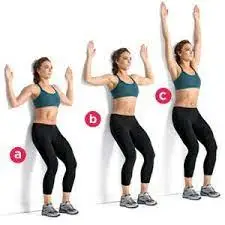
Reverse fly
- Hold dumbbells at your sides while standing with your feet shoulder-width apart.
- To pull your chest forward and nearly parallel to the floor, bend your hips back.
- Keep your back straight, your core strong, and your knees slightly bent as you let the weights hang straight down.
- When you exhale, raise both arms to your sides. Maintain a gentle elbow bend.
- Pull the shoulder blades towards the spine, squeezing them together.
- As you take a breath, return the weight to its initial position.
- Throughout the exercise, keep your chin tucked in to maintain a neutral spine and avoid hunching your shoulders.
- Then return to your neutral position.
- Then relax.
- Repeat these exercises 5 to 10 times.

Standing-side-bend-stretch
- Place your arms at your sides and place your feet hip-width apart.
- Inhale deeply, then raise your left arm straight up above your head.
- With your right arm by your side and your left arm outstretched, bend your body to the right as you release the breath.
- Hold this position for a few seconds.
- Feel the left side of your body become stretched.
- After taking a breath, put your arms by your sides and resume the starting position.
- Bend your upper body to the left and raise your right arm overhead to repeat on the opposite side.
- Then return to your neutral position.
- Then relax.
- Repeat these exercises 5 to 10 times.

Knee to chest stretch
- To begin, place your feet flat on the ground, bend your knees, and lie on your back.
- Your hand should be placed just below your kneecap or behind your knee.
- Now pull your knee up to your chest.
- Hold this position for a few seconds.
- Then drop your leg.
- Then return to your neutral position.
- Then relax.
- Repeat these exercises 5 to 10 times.

Which safety precautions must be taken when exercising?
Perform a warm-up first.
- Always start with mild, energetic movements.
- Through muscle warming, increased blood flow, and decreased stiffness, this reduces the likelihood of worsening the stress.
Start slowly and work your way up.
- Too much stress may result in problems or flare-ups early in the healing process.
- Start with low-resistance, bodyweight workouts.
- Gradually increase the weight of the dumbbells or resistance bands.
- Increase the number of repetitions before adding resistance.
Use the Correct Form and Technique
- Poor form could worsen a pain or cause other problems.
- To monitor posture, utilise mirrors or supervision as needed.
Be Aware of Your Body
- If you get shooting, stabbing, or sharp pain, stop immediately.
- Consult a physician if the pain spreads to your arms or legs.
- Fatigue or muscle pain is common, particularly if it is mild and disappears within 24 to 48 hours.
Be mindful of balance and control.
- Select an even surface for your balancing activities.
Slowly and gradually stretch.
- Avoid jumping or overstretching.
- Hold each stretch for a few seconds without pushing the process.
After your workout, relax.
- Relaxation of muscles and stiffness can be avoided by gently stretching and regulated breathing.
- Don’t stop suddenly without performing any exercises for recovery.
Remain Consistent While Taking Breaks When Needed
- Exercise three to five days a week, depending on your level of effort.
- Active relaxation or recovery should take up at least one day.
- Since muscles heal themselves when you’re not moving, get enough rest.
Utilise help if it is needed.
- For support, use a hard, not a soft, exercise mat.
- Use lumbar support, a towel roll, or a cushion to reduce the tension on the spine during certain activities.
Keep Your Breathing and Hydration Correct
- Dehydration might result in fatigue or muscle cramps.
When did you stop exercising?
This guide explains how to effectively recover while preventing harm by knowing when to slow, stop, or seek assistance.
Pain that radiates or is severe
- Stop immediately if you encounter:
- Pain that is sudden, intense, or severe
- Numbness, tingling, or burning sensations
Muscle cramping or spasming
- If your lower back suddenly begins to cramp or spasm, stop working out.
- This could mean that your muscles are overworked or not ready for this level of effort.
Loss of Stability or Weakness
- To avoid more harm, quit if you feel weak or unstable.
- If you have any of these symptoms, stop doing physical activity, put on ice, and take a break.
Increased Pain While Engaging in or After Exercise
- During rehabilitation exercises, little soreness is typical.
- Stop the workout or alter it if the pain gets worse while you move.
- The pain doesn’t go away with time and lasts for more than an hour or two after an activity.
Signs of Fatigue
- Your risk of injury increases when you’re fatigued.
- Excessive fatigue also affects coordination and body control.
If you experience pain in your middle back, which workouts should you avoid?
Some movements and activities can worsen your middle back pain or its symptoms. In order to protect your middle back while staying active and working towards recovery, this thorough guide outlines which exercises you should avoid.
High-impact cardio
- Running or high-impact workouts like burpees, box jumps, and jump squats can cause repetitive stress on the spine, which may worsen middle back pain.
- Such motions can worsen the symptoms of a pre-existing medical illness, such as a disc rupture or strained muscle.
Overdoing Deadlifts
- When performed incorrectly, deadlifts impose a lot of strain on the entire spine, but notably the middle back.
- The activity may result in disc compression or strained middle back muscles because it requires bending and lifting a heavy weight.
Sit-ups and crunches
- Because they force your spine to twist frequently, traditional crunches and sit-ups can put a lot of strain on your middle and lower back, particularly if your core is weak or the exercise is done incorrectly.
- Muscular imbalances may arise from overusing the rectus abdominis without properly exercising other core muscles.
Strong Twisting Motions
- Exercises that produce excessive twisting of the spine, such as weighted torso twists, Russian twists, and other sports, might strain the muscles or worsen the middle back discs.
- The facet joints of the thoracic spine are also strained by these movements.
Lifestyle modifications and prevention strategies for middle back pain:
Make your core muscles stronger
- Develop the surrounding muscles in your back to support your spine and ease the strain on your lower back.
- Our core muscles need to be relaxed with specific exercises because they are used in day-to-day activities.
Setting Up an Ergonomic Workstation
- Move the screen display up to eye level.
- Maintain the mouse and keyboard at elbow height.
- Make use of a chair that provides enough spinal support.
- Every thirty to sixty minutes, take a moment to stand or stretch.
Engage in Regular Exercise
- To support the spine, concentrate on building up your back and core muscles.
- To lessen stiffness, include flexibility activities like yoga or stretching.
- Walking, swimming, and cycling are examples of low-impact exercises that increase circulation and lessen strain.
Sleep Position and Mattress Selection
- A medium-firm mattress can help maintain the correct position of the spine.
- Strain can be lessened by sleeping on one’s side or back with a pillow between the knees.
- Don’t spend too much time sleeping on your stomach.
Handling Stress
- Tension in the mid-back muscles can be caused by stress.
- Tension-reduction techniques include deep breathing, meditation, and relaxation exercises.
Stay away from extended periods of inactivity.
- Prolonged standing, driving, or sitting could worsen pain.
- During the day, shift positions regularly.
Pay attention to your weight.
- Being overweight strains your back.
- Supporting too much weight might cause your spine to become twisted and under improper tension.
- The back may no longer receive enough support when the natural curvature of the spine develops over time.
Lift correctly.
- It’s easy to twist in the wrong direction when lifting something heavy.
- Muscle aches and spasms could result from it.
- Use your legs rather than your back to lift heavy objects for improved body mechanics.
- Get assistance if you are unable to lift the object on your own.
Avoid having a bad posture when you sit.
- Your lower back’s discs are subjected to significantly greater strain when you sit poorly than when you stand. If you have to sit for long periods of time, don’t forget to occasionally get up and walk around.
Summary:
Maintaining proper posture, supporting the spine, and promoting mobility all depend on the mid-back. You can tone this area by incorporating a productive workout into your daily schedule. It may also lead to a stronger and healthier spine.
There are numerous reasons for middle back pain. These can include chronic inflammatory diseases, poor posture, muscle weakness, and spinal cord impact injuries.
Prevention may not always be possible, and treatment will usually vary based on the underlying reason.
Targeted exercises can help you build more tone and strength in the middle section of your back. A solid and well-defined mid-back is essential. This has an impact on spinal health, functional fitness, and general posture.
Maintaining good posture and doing regular mid-back workouts may help prevent pain. Throughout the day, you should also be mindful of your posture, particularly when focusing on inactive work.
You should pay attention to how much pain you are feeling when you exercise, especially when you first start. These workouts may first make your symptoms a little worse. Regular exercise, however, can help increase back mobility and should become easy with time.
Make sure to speak with your doctor before starting any back pain workout regimen. Depending on the cause and severity of your pain, some workouts might not be recommended or might even be unsafe.
FAQ:
How can my core be strengthened?
Include exercises like planks, bridges, and hamstring stretches in your routine, and be sure to maintain proper posture. During these exercises, focus on using your back, pelvic, and abdominal muscles.
How often should I do these exercises?
Try to do this three to five times a week, depending on how fit you are and how bad your pain is. Mix up your strength, flexibility, and stretching exercises. Include days of active rest or recovery.
Can these workouts help with posture?
Yes. Many exercises for middle back pain involve correcting your posture, especially if the pain has been caused by rounded shoulders, forward-leaning head posture, or prolonged sitting or slouching. Strengthening your upper back and core will progressively improve the posture of your spine.
How long does it take to see results?
Most people feel better after two to four weeks of consistent, proper activity. Improvement varies depending on the cause and severity of the pain. Continue to incorporate mobility and posture into your everyday activities.
Why would someone get pain in the middle of their back?
A person’s middle back may pain for a number of causes, from bad posture and strained muscles to more serious illnesses like kidney stones, scoliosis, or osteoarthritis. If a person’s middle back pain does not go away after a few weeks of at-home treatment, they should consult a doctor.
What are some ways to alleviate middle back pain?
First-line treatments for middle back pain include heat therapy, over-the-counter painkillers, and posture corrections. The middle back muscles may also be strengthened and stretched by performing focused exercises like stretches and low-impact activities.
Is poor posture the only cause of middle back pain?
Indeed, long-term poor posture puts stress on the thoracic spine and surrounding muscles, leading to pain and stiffness.
Is it safe to perform exercises when experiencing middle back pain?
Yes, low-impact, gentle activities are safe and frequently helpful. If you’re unclear about a particular activity, though, speak with a physiotherapist.
Which stretches are effective for middle back pain?
Seated Spinal Twist.
Doorway stretch.
Figure Four.
Cat-Cow.
Child’s Pose.
Can I have physiotherapy treatment every day?
You might need to attend to rehabilitation every day, depending on your health and the course of your treatment. While some people may need pauses to prevent stress, others may find it beneficial to avoid them in between sessions. Never ignore your therapist’s recommendations about what works best for you.
References:
- S. Heyn (2025, Sept. 2). Five stretches to help your mid-back relax and release tension. Health Line. Stretches for the mid-back https://www.healthline.com/health/fitness-exercise
- Bariya, D. May 19, 2025a. The top 16 physical therapy exercises for middle back pain. Exercise and physical therapy treatment. https://physical-therapy.us/middle-back-pain exercises
- C. L. P. D. Ocs (2019, Dec. 30). Five exercises to help with middle and upper back discomfort. Spinal health. This article describes exercises for upper and middle back pain.
- March 21, 2022: Arizonapain. 11 discomfort relief exercises and stretches for middle back discomfort | Arizona Pain. Arizona Pain. Exercises for Middle Back Pain: https://arizonapain.com/instructions
- S. Bean (2023b, Dec. 28). These are the top 15 middle back exercises for every injury therapy. Chiropractic for All Injury Rehab. This link will take you to a list of middle back exercises.
- Exercises for Mid Back Pain (MSK Patient Portal) – NHS Ayrshire & Arran, n.d. Exercises for thoracic mid-back pain https://www.nhsaaa.net/musculoskeletal-msk-service-patient-portal/mid-back-pain-exercises-msk-patient-portal/
- Leonard, J. June 14, 2024. The causes and treatments of middle back pain. Articles: 321195 https://www.medicalnewstoday.com
- Inc., S. R. (January 24, 2025). The Best Exercises, Causes, and Treatments for Middle Back Pain. Rehab Synergy Inc. Middle back pain: https://synergyrehabinc.com/


